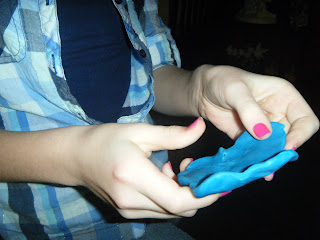
Real Life Science Experiment

 Step 1: Place the ruler on the paper and trace around it.
Step 1: Place the ruler on the paper and trace around it. Step 2: Cut out the strip, and divide it into six equal parts.
Step 2: Cut out the strip, and divide it into six equal parts.

It sinks also!




How does this work?
Whether something sinks or floats has nothing to do with how much an object weighs. We didn't change the weight of the obects; we changed the shape. An object floats or sinks based upon how much water is displaced, or "pushed aside." The "boat" made out of clay was bigger than the ball of clay and displaced, or pushed aside, more water causing it to float. The marbles couldn't float because they were small and couldn't push enough water out of the way to equal the same weight. So, it is important to remember that anything that floats weighs the same as the water pushed out of the way. There is another factor that determines whether an object sinks or floats. Density also plays an important part.
What is density? Density is a measure of mass per unit of volume
Density = mass/ volume
What is volume?
Volume, also called capacity, is a quantification of how much space an object occupies.
The density of an object depends upon its weight and size(or voulme).If two solid objects are different sizes, but weigh the same, the smaller object is more dense because it is more compacted.
If an objects floats on water, then it is less dense than the water itself. If it sinks, then it is morse dense than water.
Here's a look at density: http://www.nyu.edu/pages/mathmol/textbook/density.html
These very principles are also used in shipmaking and boat making. Even though some boats are huge, they still float. This is because they are metal shells that are filled with air. They are less dense and lighter than the water they push aside, or displace, and this allows the boat to float.
I think this would be a great experiment to use in the classroom. I think everyone wants to know just how a boat can float when it is so big. I know when I was a child it amazed me to see such big ships floating on the water. It even amazed me that I could float in the swimming pool. :) This experiment could be used to teach about density, water displacement, and volume. Students could also have fun with the experiment by seeing who could make their boat hold the most marbles.
Here is a website that calculates density for us: http://www.1728.com/density.htm
After conducting the experiment, Megan and I learned that the sun appears oranges when it is setting because of the particles in the air. Here is a website that explains it: http://scifun.chem.wisc.edu/HOMEEXPTS/BlueSky.html
In this video, Megan demonstrates what the sun looks like when it is high in the sky, and then what it looks like as it is setting. As the sun sets, it often gives off a red or orange color. Here is a site that gives some interesting facts about the sun: http://library.thinkquest.org/J002231F/Sun/factsaboutthesun.htm
Me and Megan done an experiment that shows what it looks like when the sun is setting. We done the experiment in three parts, this one being the first. Before we started our experiment, we asked ourselves the question, "What makes a sunset appear orange or red?" We came up with the hypothesis that the sun appears orange when it is setting because it is closer to the earth, and the earth is bouncing the sun's rays off giving it an orange color. Watch to see if we are right!
All three parts of "See a Sunset" refers to Tennesee State Standard GLe 0207.6.1- Realize that the sun's position in the sky appears to change. Sunsets could be discussed when talking about the sun and how it appears to change positions in the sky.